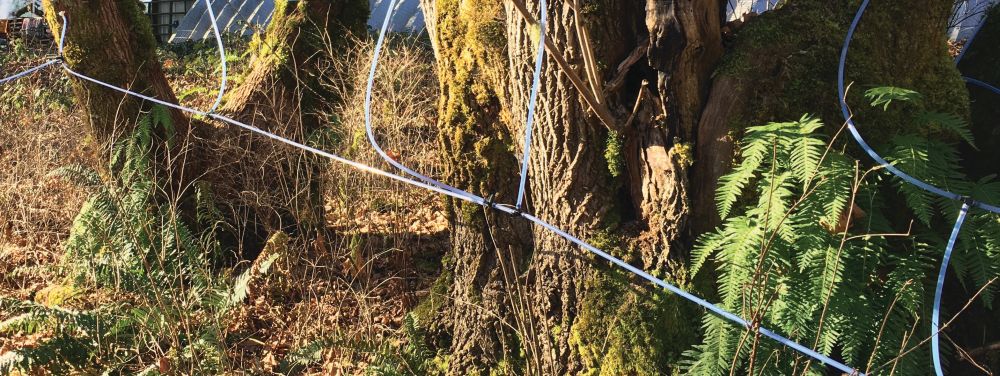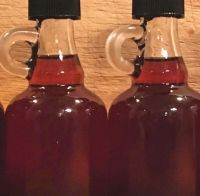
The sugar maple has a reputation as a powerhouse for maple syrup production — but it’s not the only maple game around. An interdisciplinary team of researchers led by the College of Forestry is at the forefront of a movement to tap into Oregon’s bigleaf maple. The goal? Put the Pacific Northwest on the maple syrup map.
“This is a great economic opportunity for Oregonians to build an industry centered around the bigleaf maple, particularly in western Oregon, where the tree is especially abundant,” says Eric Jones, the principal investigator for the project and assistant professor of practice at the College of Forestry.
So why hasn’t a bigleaf maple tapping industry taken off before in the Pacific Northwest? Economics. The bigleaf maple, acer macophyllum, has less sugar in its sap — usually about one-third to one-half — than the sugar maple. So instead of needing around 40 gallons of sap to make a gallon of syrup, as is the case with sugar maple, you need 80-90 gallons of bigleaf maple sap. But technology advancements like food-grade vacuum tubing that extract higher volumes of sap from trees and commercial reverse osmosis machines which remove 75 percent of water from the sap, have resulted in a cost-effective way to turn less sugary sap into syrup.
“This technology is a gamechanger for the bigleaf maple,” says Jones. To help establish a sustainable bigleaf maple industry in Oregon, Jones assembled a diverse research team including scholars and students from anthropology, food science, extension, geography, environmental arts and humanities, economics, ethnobiology and engineering. The U.S. Department of Agriculture awarded the team $1 million in funding through a pair of multi-year awards to promote the emerging industry, provide training and educate landowners interested in developing commercial enterprises.
“I think there’s a romance and infectious nature to tapping bigleaf maples and we’re trying to help landowners find the easiest and most economic and ecologically prudent path to get into ‘sugaring,’ as they refer to it in the maple industry,” says Jones.

Besides producing maple syrup with a complex flavor profile, the bigleaf maple is the source of other products like nutritional maple water, edible flowers, honey, lumber, figured wood and firewood.
The research team is working to mitigate the risks involved with managing and sugaring bigleaf maples, including incorporating food safety standards into commercial production and investigating how wildlife, diseases and different climatic conditions affect bigleaf maple stands.
With climate change ushering in greater uncertainty about the future of Pacific Northwest forests, the team is interested in how the trees will fare under changing conditions. While hotter and drier weather in some areas will negatively impact bigleaf maple populations, the trees may prove resilient in certain microclimates. Jones is currently an advisor on a pilot project in Washington, where the group is planting thousands of bigleaf maple trees on old dairy land as part of a carbon offset program.
“The bigleaf maple is a tenacious tree, as any forester will attest to, and perhaps it has a role in helping mitigate climate change,” says Jones.
Jones hopes that a growing maple industry will invite people to develop a deeper appreciation for the land and find new ways to engage with each other and with Oregon’s biodiverse and ecologically complex environment.
“Our team of researchers is working hard to make the emerging bigleaf maple industry an inclusive and equitable economic opportunity,” Jones says. “We hope to ignite a bigleaf maple culture in the Pacific Northwest like the sugar maple culture in the Northeast.”
In May 2023, the team will hold the first bigleaf maple festival in Salem, Oregon. Learn more at www.oregontreetappers.net.
THE RESEARCH TEAM
Eric Jones – CoF principal investigator
Melanie Douville + John Scheb – CoF graduate students
Barb Lachenbruch – CoF professor emeritus (tree physiology)
Ron Reuter – CoF associate professor (soil science)
Badege Bishaw – CoF courtesy faculty (agroforestry)
Tiffany Fegel – Forestry and Natural Resources, Extension coordinator
Lisa Price – OSU professor (ethnobiology)
Joy Waite-Cusic – OSU associate professor (food safety)
Ann Colonna – OSU senior faculty research assistant, (sensory testing)
Rebecca McLain – Portland State University (ethnography)
A version of this story appeared in the Spring 2023 issue of Focus on Forestry, the alumni magazine of the Oregon State University College of

